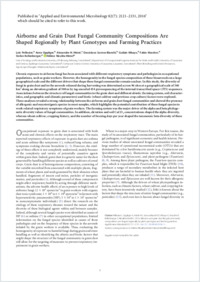Airborne and grain dust fungal community compositions are shaped regionally by plant genotypes and farming practices
- Pellissier, Loïc Unit of Ecology and Evolution, University of Fribourg, Switzerland
- Oppliger, Anne Department of Occupational Hygiene, Institute for Work and Health, University of Lausanne and Geneva, Epalinges-Lausanne, Switzerland
- Hirzel, Alexandre H. Computer Science Center, University of Lausanne, , Switzerland
- Savova-Bianchi, Dessislava Department of Occupational Hygiene, Institute for Work and Health, University of Lausanne and Geneva, Epalinges-Lausanne, Switzerland
- Mbayo, Guilain Department of Occupational Hygiene, Institute for Work and Health, University of Lausanne and Geneva, Epalinges-Lausanne, Switzerland
- Mascher, Fabio Plant Breeding and Genetic Resources, Agroscope Changins-Wädenswil, Nyon, Switzerland
- Kellenberger, Stefan Plant Breeding and Genetic Resources, Agroscope Changins-Wädenswil, Nyon, Switzerland
- Niculita-Hirzel, Hélène Department of Occupational Hygiene, Institute for Work and Health, University of Lausanne and Geneva, Epalinges-Lausanne, Switzerland
-
04.01.2016
Published in:
- Applied and Environmental Microbiology. - 2016, vol. 82, no. 7, p. 2121–2131
English
Chronic exposure to airborne fungi has been associated with different respiratory symptoms and pathologies in occupational populations, such as grain workers. However, the homogeneity in the fungal species composition of these bioaerosols on a large geographical scale and the different drivers that shape these fungal communities remain unclear. In this study, the diversity of fungi in grain dust and in the aerosols released during harvesting was determined across 96 sites at a geographical scale of 560 km2 along an elevation gradient of 500 m by tag-encoded 454 pyrosequencing of the internal transcribed spacer (ITS) sequences. Associations between the structure of fungal communities in the grain dust and different abiotic (farming system, soil characteristics, and geographic and climatic parameters) and biotic (wheat cultivar and previous crop culture) factors were explored. These analyses revealed a strong relationship between the airborne and grain dust fungal communities and showed the presence of allergenic and mycotoxigenic species in most samples, which highlights the potential contribution of these fungal species to work-related respiratory symptoms of grain workers. The farming system was the major driver of the alpha and beta phylogenetic diversity values of fungal communities. In addition, elevation and soil CaCO3 concentrations shaped the alpha diversity, whereas wheat cultivar, cropping history, and the number of freezing days per year shaped the taxonomic beta diversity of these communities.
- Faculty
- Faculté des sciences et de médecine
- Department
- Département de Biologie
- Language
-
- English
- Classification
- Biological sciences
- License
-
License undefined
- Identifiers
-
- RERO DOC 261061
- DOI 10.1128/AEM.03336-15
- Persistent URL
- https://folia.unifr.ch/unifr/documents/304979
Statistics
Document views: 91
File downloads:
- pdf: 159
